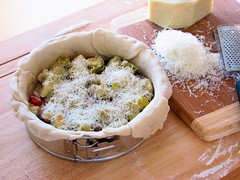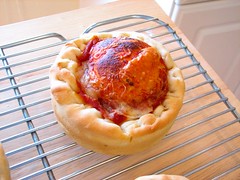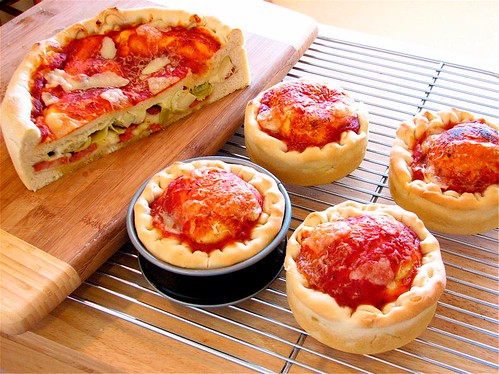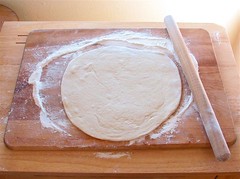Stuffed pizzas are a Chicagoan delicacy consisting of layers of cheese and fillings above– and below– a thin pizza crust. One of the best ways to bake them is in a springform pan, so that the sides come out in perfect cylinders and come out easily. Taken to the small extreme, individual-sized stuffed pizzas are the ideal portable food to take to work for lunch. Made in miniature springform pans, they are compact, cute, tasty, filling, and are almost guaranteed to make your co-workers jealous. Read on and we’ll show you how to make your own springform stuffed pizza, in any size you like.
The common wisdom on making stuffed pizza is that it should be made in a “deep dish pizza pan,” which is nothing more than an overgrown (wide) cylindrical cake pan. You can find these both with true cylindrical sides as well as with angled sides, like an overgrown pie pan. However, you’ve got a problem in either case.
With true cylindrical sides, it’s a trick to get the pizza out in once piece, and with the angled sides, well, you’ll never have a properly shaped stuffed pizza.Slightly better than a deep-dish pizza pan is the old standby: a large, well-seasoned, cast iron skillet. We used to make all of our stuffed pizzas this way, and it actually works fairly well: the sides of the pan are sloped just enough that you have some hope of getting it out, but not so much that the result no longer resembles stuffed pizza. Unfortunately, this was still not a perfect solution because the bottom of the pizza has a tendency to stick to the bottom of the skillet, making it difficult to impossible to remove. (And if you don’t take the pizza out of the pan, you have the weeping lasagna problem. Later, the leftovers ooze when reheated.)
Finally we got a little bit smart about this and used other kitchen gadgets to solve this problem: springform pans. We are certainly not the first people to figure out that springforms are the optimal vessel for stuffed pizzas, but we do wish that someone had told us sooner.
Springforms come in a variety of sizes and we’ve gotten into the habit of making both large and small versions whenever we make stuffed pizza.
We serve the large one immediately (for dinner), and save the smaller ones for lunches over the next few days. As soon as they have cooled to room temperature, individually seal them in plastic bags and put them in the freezer. They store and reheat remarkably well. You can pull one out in the morning on your way out the door and there is no need to put it in the scary work refrigerator – it will still be cold at lunch time. After a minute or two in the microwave, you’ve got perfect lunch.
For this demonstration we’ll be making one large pizza in a ten inch springform and four small ones in four-and-a-half inch mini springforms.
Most of the photos that we show are of the large pizza because it’s, well, larger and therefore easier to photograph. But the real winners are the little ones.
You can use your favorite dough recipe, but if you need one to start with, try this one. (Note that we haven’t yet tried the accompanying filling recipe – we usually improvise the fillings. Also note that she uses a springform!) Assume that you need one typical batch of dough for either one large or four small stuffed pizzas; we’re using a double batch for our set of five pizza.
Once your dough is happy, you can begin rolling out the crusts. If you’re making more than one pizza, pick out one pizza’s worth of dough to work with.Divide the dough into two uneven parts.
Roll the larger portion out as the bottom crust: a large even circle of dough. We rarely use a rolling pin for pizza – unless we’re making stuffed pizza. You need nice even thin dough for this, and it should be significantly larger than your springform. Aim for 1/8″ to 1/4″ thick, but uniformity is more important than the actual thickness.


Lightly oil your springforms. We pour a little olive oil on the bottom and spread it around with a paper towel, but you’re welcome to fuss with basting brushes or whatever other method you like.
To begin the actual assembly, drape the large circle of dough over the springform pan.
You want enough to drape over so that even after you have tucked the dough into the corners, there is enough left over the lip to hold the dough up. Gently tuck the dough into the corners of the pan.
 Patch the edges of the crust, as needed, to make sure that the crust extends up high enough.You can now begin filling the pizza. We like to start with a thin layer of grated or sliced provolone on the bottom.>
Patch the edges of the crust, as needed, to make sure that the crust extends up high enough.You can now begin filling the pizza. We like to start with a thin layer of grated or sliced provolone on the bottom.>
Now it’s time to get creative and add your fillings. For a more traditional pizza, you might want to put in a layer of italian sausage or spinach, but we’re rather prone to culinary experimentation. We stuffed these particular pizzas with chicken andouille sausage and marinated artichoke hearts. (Is that combination good? Oh-my-god, yes.)

Put a layer of parmesan or pecorino romano on top. We advocate the use of microplane graters for optimally fluffy cheese.
If you are a cheese lover, top the inside of the pizza with another thin layer of provolone. Roll out your tops and drape them across.
Trim dough even with the top of the pan. Crimp the edges down like you would for any old pie. And, just like for dessert pie, pierce the top to allow steam to vent.
Top with a layer of pizza sauce and garnish with cheese. Look at all those pies ready to be baked! (Click the pictures to zoom in for a better look!)
Bake at 375 to 400 degrees for 35 to 45 minutes. Take the pans off as soon as you take them out of the oven. This will prevent them from getting soggy as they cool. And even if you’re starving, let them cool for about 10 minutes before cutting one open.


That way they’ll look like this. It makes us glad that we put some in the freezer for later. Enjoy!
















Amazing: from Slashdot to Hack-a-day to this.
Looks:
– simple (I do not, as a rule, cook, so this is important);
– delicious
– in my near future.
I like this, the Idea of a pizza on a pizza for some reason never came to me. but it works great
This looks amazing and so much fun too! I can’t stop thinking of possible filling options!
will it be cooked properly since its so thick? can i bake the bottom layer first before toping with the second layer?
It cooks pretty evenly from all sides in. The bread will get cooked. If you don’t cook it long enough, your cheese in the middle may not melt all the way.
—
Windell H. Oskay
drwho(at)evilmadscientist.com
http://www.evilmadscientist.com/
These look awesome! Now I need to go get some of these baby springform pans!
Looks delicious! I love the idea of using a springform pan for this.
Such a great recipe! Had to repost it: http://momentumoffailure.wordpress.com/2009/03/27/miniature-stuffed-pizzas/
You left out the herbs. Sorry but I get Italian Herb blend from an online called Juliet Mae Spices. I have put this herbs on pizza and in spaghetti. Now its not Italian without it. Also the photography is excellent. Drat, now I want some gooey cheese…
I’m getting hungry looking at those pizzas!
a nice idea!!!
When does a topped calzone become a stuffed pizza? Discuss.
Whatever you call them, these look great.
For better or worse, we didn’t name these– Stuffed Pizza is a Chicago specialty; we’re just trying to spread the idea around. :)
Windell H. Oskay
drwho(at)evilmadscientist.com
http://www.evilmadscientist.com/